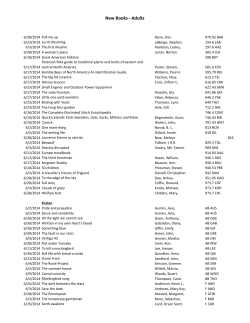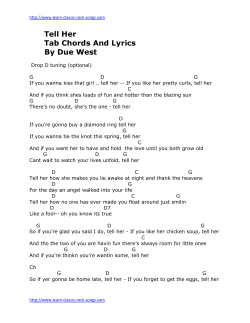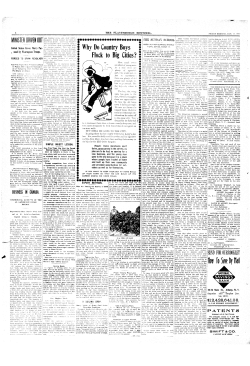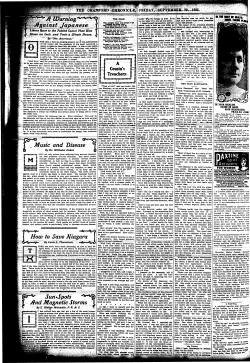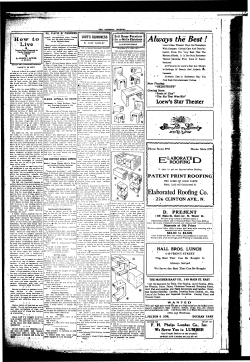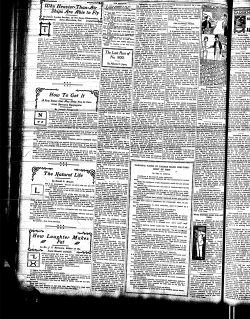
Document 198766
• « . : ' > ; y\ ••.;•••; "'v4' swa^w? AUTOMOBILE SECTION ' " ^ };• :-• -\r SCHENEGTADY GAZETTE, MONDAY MORNING, FEBRUARY 20, 1928. FINE EVOL III COMPOSITE AS REVEALED AT MOTOR SHOW OF 1928 duction ratios and adjustability of the N e w Models A r e B a s e d U p o n Old, b u t I m p r o v e d in steering gear angle. Adjustability of both clutch and pedals or of the driver's seat to so M a n y P o i n t s as to Seem Radically Different brake permit a person of any eize to drive a — C o m p o s i t e P i c t u r e Shows I m p r e s s i v e P r o g r e s s car of any proportions. A car of this character Is expected to prove almost irresistible. That is in E n g i n e D e s i g n and Construction, in A p p e a r - what tho automotive industry wants, for it wants another 4,000,000-plus car ance of Body, and in Chassis F e a t u r e s . year this year. And, all things being equal, it Is very likely to get It despite the faot Evolution is no mere theory .In the automotive industry. It is a that 1927 was not entirely perfect. practice and its results mayo be scon with half a n eye whether the object of one's glance is the most inexpensive or the most expensive car. Each year the automobile designer h a s evolved something: better in appearance, performance, durability, economy, and In every other way. Recently this evolutionary process has begun to bear fruit at much shorter intervals than a year apart, and the result is that the public has found itself unable to keep tip with the many advances, if it cannot keep up with, events as they happen, however, it has opportunity to catch up with them in the annual automobile exhibitions. Motor Sales In South American mar. Improvements. kets should Increase with economlo What do tho automobile shows re- many ordinary purposes, where brake gains predicted by competent observers veal in the form of new cars and lining now is consumed by the average for the next two years. driver,. improved cars? Approximately 90 per cent of all moSuch an engine obviously is the prod- tor vehicles Imported by South AmeriA composite picture of the cars displayed at tho show reveals these en- uct of an evolutionary process in which can countries are of American make. the entire field of car manufacture One British manufacturer Is erecting gine features: An engine of slightly greater bore, finds itself. As one famous consult- an assembling plant In Argentina and with resultant greater power duo to ing automotive engineer sums it up: a Continental automobile maker, plans "Kngincs have been getting this Way a similar establishment in Brazil. larger piston displacement. The chief Impediment to motor sales An engine of higher compression for years." He meaiiB, of course, more ratio to take advantage of the better powerful, smooth, and flexible as well Is lack of adequate highways. Highway construction is 'somewhat complicated fuels both in the form of better and as lighter and more durable. Body Changes. In several countries because of vast more economical performance. An engine with a new manifold deThe evolutionary process that is to areas covered by the properties of signed to distribute the vaporized fuel be noted In the engine is probably single owners. Popular enthusiasm for evenly to all cylinders—particularly in even more conspicuous In the body. A good roads has been aroused nearly the case of six and eight-cylinder en- composite of the models for 1928 everywhere, however, and Increased road building is looked for In the near gines. This manifold will utilize en- shows: gine heat for a further increase In Deep, slender-looking radiators, sur- future. Motor transport Is being looked on efficiency. mounted by an effective ornament. An engine whose cylinder wall, inStill narrower body posts to Increase with more favor by government officials, particularly In Chile. Realization stead of being tho conventional gray visibility. iron casting, will include some nickel Interior hardware made of higher- that a low tax will stimulate motor or chrome-lilckel to give them greater grade materials and less ornate In de- registration and that * governmental gross revenue will increase in the long wearing qualities. sign. An engine whoso designers recognize Heavier fenders and much more sub- run Is growing: Lowered Import duties that the different functions of exhaust stantial running boards, whether the and motor taxation may result. ana Inlet valves not only permit but material for the latter Is wood or There Is an Increasing tendency for dictate the use of different materials metal. women to drive cars on the East Coast. 'and, in some cases, different forms for Open cars are most popular in Brazil A departure from the vertical louver each. Incidentally, many englnea show In favor of tho horizontal or diagonal, and other coentrles near the equator. the use of dual valve springs or simi- a further expression of a trend that Closed cars arc making gains In Arlar arrangement to eliminate breakage has been manifest for the last 12 gentina, Use for road building and by due to higher stresses. progressive farmers is broadening the months. More Aluminum. Wider, more form-fitting, deeper- market for light, rugged trucks. Existing: bus lines are being extended An engine that involves greater use cushioned and better-upholstered seats. Greater leg room In the driving com- and new lines opening up. Railways of aluminum and aluminum alloys In are looking toward the motor vehicle partment. pistons and connecting rods. Comfort, convenience and better ap- for feeder lines and increased truck An engine that uses some form of vibration dampener as recognition of pearance are the objectives of the de- and bus sales are expected to result. the fact that counterweights do not signer that have been brought out In ¥ eliminate this annoyance, but rather this significant group of changes. aerve merely to reduce or better dis- These goals have been .particularly aptribute the loads on main crankshaft parent in the ears that have been Introduced since mid-summer of 1927. If bearings. An engine of no greater r. p. m. one looks closely enough at the new ine^Pbut';«'£' higher < power and more models, he can see the skeleton of the 5 appealing smoothness, <, old automobile, But it does require a At tho ond of 1927 General Motors QUtfo a [piece of automotive power, close look In many cases. Take tho Acceptance Corporation had In operaapparatus,-thla compos! to of what la car one owns and compare It with tho tion 21 branch offices in overseas being-"revealed In tho 1928 automobile latest model of tho same make. It is countries, operating along tho same •hows. One of the most encouraging, hard to see tho old In the n|w, but it llnoa nB domostlo branches in provideigns about It. from the engineering- Is there If the vision is not' beclouded ing credit servlco to the retail pur* •viewpoints is t.hat It Is built,upon reo-J by desire for the.new car. More evp- chaser of GeneraM Motors products. ogniUon that the automobile engine la1 lutlon. The acceptance corporation's foraltogether, too b,eavy In, .pound* per The composite chassis has. these im- eign volume for the year totaled over hors*po\ver—a lesson learno^ fr6m:tbe' proved features; * ; 170,000,000, representing a large Inairplane engine. This ne"*r lightness l o n g e r rear ' springs, with fewer crease In business over 1926. la achieved, of course, by the use of leaves, and new notes In suspension. >• Credit buying of automobiles Is rap.llgfctefc-^rtMiterlals, aluminum • In most Lighter frame materials, with a idly being extended in overseas counInstances. greater, number of connecting members tries and an even greater growth is The cars powered with this engine to give rigidity and compensate for the looked for In the acceptance corpora; come fairly close to exceeding the mo- lightness of tho metals used. Drop tion's business for 1928 with tho Intorist's ultimate hope in flexibility, to frames to achieve low over-all height. creased demand for General Motors acutely needed In the face of conges* Smaller wheels with no uniformity produots throughout the world. tioh. It is a faster car and more aa to ^wlre, artillery or disk. BUYS FBOM 4600 C0K0ERN8 potent on hills. And, it Is worthy of Wider rjsar tread to permit a f e a r note, it Is a car in which the engine Beat of greater width. M"ore than 4,600 concerns supply maIs an amazingly efficient brake for Easier steering through greater re- terials for Goneral Motors products. Ninety Per Cent Of Cars in South America From Here Credit Buying in Foreign Countries Two Hundred More Clubs in the A. A. A. Membership, Resources and »• Services of Organization Progress in 1927. By ERNEST >'. SMITII General Manager, American Automobile Association "When the first gasoline automobiles appeared on our streets a little more than a quarter century ago, motordom was beginning a healthy infancy. Its wants, like the Infant's, were few and similarly easy to satisfy. As motordom expanded and the number of cars In use multiplied, it Decerns more apparent that Its problems were growing Increasingly complex. The question then was how should they be solved, individually or collectively? The logical step In the direction 'of satisfactory solution was the organisation of motordom, and this was accomplished jn the formation of the motor club. This was the body deBtlried to become motordom's way of expressing its desire, providing for Its needs, and generally protecting Itself against harmful and unfair tactics. In seeking out automobile owners to organise <thero for their mutual benefit and proteotlon, the motor club was In a position to point to a definite program the accomplishment of which would enable motorists to avoid burdensome taxation, to have available good roads stretching throughout the nation, and to be'enabled to use their cars with the assurance that their tours would be charted, all emergencies provided for, and various annoyances eliminated which otherwise, would threaten to cast the shadow of discomfort over the travels of the motor car owner up and down the highways. To- this task the American Automobile Association and its affiliated olubs have directed.their endeavors during the 25 years In which they have labored In the Interest of organized motorists. On every hand, tho highly salutary effects of organization as a principle are clearly apparent In business, In Industry, In finance—even In the arts —organization has brought and Is continuing to produce results which hitherto wero believed unattainable, O ^ ganlzatlon is not a panacea, but it is, very surely and definitely, an Important milestone in the achievement of efficiency and general progress. Founded In 1902, when the motor car first was beginning to attract a measure of public attention, the American Automobile Association from that day to this never has left the lists it entered to defend and extend the rights and to protect the privileges of the motorist, and at the same time to forward In every possible constructive way motordom's and the public's Interests. Consequently, with a growing appreciation of the value of the high-minded service rendered there has been an ever-widening recognition in the form of hundreds of thousands of e n t r a n t s ' i n t o the ranks of organised motor ownership, Civic Institutions Starting small, as all* great movements must, the motor club has gained strength with the most amazing consistency. Today, It has become 'a great clvlo institution and with the growth of its membership and facilities it Is devoting more and more of its resources to publio service activities. The wideawake motor club of the present is taking the leading part In promoting publio safety, and much of the progress of the safety movement In America can be traced to the activities of organised " motordom, as represented by the motor club In its community, This is, of course, altogether apart from service to,members and is but another proof that a motor club la in reality today a eeml-publlo utility, fully conscious of the role it is called upon to exercise.' No section of the country, however remote from tho main center of population, has failed to reveal .increasing interest In the motor club a s a n outstanding factor of Importance t o , m o tordom as a whole and to the motorist as an individual.' Everywhere, our clubs report remarkable membership gains, and, what we consider of deep significance, member activity of all past years, now has been surpassed. By member activity, two things are meant. First, our clubs through the enterprise of their membership have participated to a greater degree than ever before in matters of clvlo Importance, not only in matters of safety but also In Improved traffic regulations, street improvements, street extension, street widening, and many other matters of similar character. SScondly, as a result of member activity In another direction, our clubs have been able to. render more and wider services. / 10,009,000 Tours i The automobile has made us a nation of nomads and out of this has grown the tremendous industry of motor touring. Communities everywhere are compeyng for motor tourist business and the most successful In this respect are those where the motor club has been working* according to modern standards and acting as hosts to the visiting, tourists from wherever they may chance to come. LaBt year 10,000,000 tours were handled across the counters of A. Ai A. clubs by more than 3,600 touring counselors. These figures, reflect the tremendous proportions this service has attained and are vitally significant of tho Yast need that Is being filled by this one phase of the motor club program. An increase of 20 per cent In 1927 in the number of new motor clubs affiliated under the A. A. A. emblem clearly shows the trend of the motorminded publio toward organisation. During the year there were a, total of 199 new clubs admitted to membership, compared to 165 In 1926, which decidedly strengthened the ranks of motordom In Its never ending fight to protect the Interests of the car owner. The trend of the motorists throughout the country Is to Join bands and op-ordlnate their efforts to aid in the program of progress of the motoring world. • Total of 958 Clubs The A. A. A. today has 958 member clubs. It Is represented In every state in the Union. Its service chain extends from coast to coast and from Canada to the Gulf of Mexico. In 25 foreign cities It has representatives who are prepared to take care of the heeds of the A. A. A. club member when he desires to take his c a r abroad. This service1 has now definitely crossed the sea. It Is a cause of the utmost satisfaction to officials of the American Automobile Association and inspires confidence among the growing 96 per cent of the functioning motor clubs of the United States are acting under the banner of the A. A. A. So we come now down to the present moment. We have seen the growth and the spread of this movement from the early days of the automobile to this very season of stock-taking. We have seen the steady advance made by it, and have noted that during 1927 It set new high marks for sound and well-conceived advances. What, then, does the future hold in store for organized motordom? Can It go on to still greater heights, or haa-lt already reached the peak? Will 1928 lead us upward, or must \Ve now travel a downward path? To us who dally are In the most Intimate contact with the motor club movement it seems clear that the pew year holds forth a glowing promise of even more Impressive achievements than we already have been privileged to witness. Wo feel that wo can say this, not merely because we wont to think that way, but on the basis of facts and figures, cold and unrelenting. . * So certain are we of our premise that we do not say that we believe AUTOMOBILE SECTION .ffitaDENSLl . ON M0TORiST8 SHOWS fflGREASE' Car Owners Paying! Nearly Two-Thirds of Annual Road Bill. GARDNER EIGHTS VER Y ATTRACTIVE Among the many attractive Gardner models, a series 95 brougham, executed two-tone in Ardsley green and Congo smoko; a 95 roadster in Roblnhood green and Abbot" gray, with yellow and gray wheel striping: a 75 sedan, dsjpe In Maxlne blue, with cream moldings, and wood wheels, with blue fenders and striping. Very striking also Is the Series 85 sedan which is finished in Alesslo wine below the belt and on top of the hood, with flat wine above the belt and on the back. Natural wood wheels are In mountain ash scarlet with black striping, moldings and fenders are in black, and molding^ and louvres are striped in mountain ash scarlet. Upholstery la In Chase sample mohair with cut design, and there is a lacy cushion to match. On all cars cushions and backs of the seats are made over form-fitting springs to assure maximum comfort even on the longest trip. American walnut finish is used on window frames and on the doors wainscoting panel, which has an Inlay of mahogany. Interior hardware Is all platinum finished and exposed-hardware on the, door pil- lars and the face of the lock is nickel plated. Exposed wood parts in the door openlng& are completely metaled. Mechanically, the Gardner 95 is a 130-inch wheelbase Job with 8% by 4^s inch Lycoming engine having a compression ratio of 5.35 to 1, 33.8 rated horse power, and delivering 115 brake horse power at 3,200 revolutions per minute; while that of eerles 85, a smaller replica of the 95, la a Lycoming 2% by 4% inches, rated at 26.45 horse power and delivering 74 brake horse power at 3,200 revolutions per minute. The compression ratio is 5 to 1. The Gardner 85 wheelbase length is 125 inches. Both series are very similar in mechanical design and details, except, of course, where dimensional differences are necessary. A description of the series 95, therefore, should enable the reader to form a picture of both Jobs. The^ 95 features In its engine, Duplex carburetor and Duplex manifolding, Bohnalito pistons, air cleaner, P»%rolator and fuel strainer, while among outstanding features of the chassis are hydraulic four-wheel brakes, of internal-expanding type, and automatlo centralized chassis lubrication. that 1928 will surpass 1827; we firmly Insist that we know such will be the case. In this we are uncompromising; failure Is not in the cards. The motor club has proved, not only to Itself, but also to the millions who have used Its beneficent rapidly expanding and forward-looking services. The motor club Is the voice of the millions who have found the automobile indispensable. It is a voice that can not, will not, .be stilled. The year, now new( will corroborate this prophecy before it ends. • RADIO IS USED IN AUTO RESEARCH B-battery eliminators, so popular these da;xs with radio fans, are utilized for various purposes in research work at the General Motors laboratories In Detroit. Special eliminators, operated to generate power for X-ray and Cathode-ray oscillographs convert 220 volts of alternating current from the commercial power line to 110,000 volts of direct current. - • Radio amplifiers are also used in research work as part of the operation of the oscillograph, which detects, defines, amplifies and records noises. When unnecessary noises are traced HAS 18,000 DEALERS .v .to their sources In motors and auto Products of General Motors are sold bodies the problem of eliminating them through 18,000 dealers and distributors What is the .value of a used car? ih the United States. " '• ' --• Having decided to trade in his pres- Is greatly «lmpllfled. ent car for a new one, the owner is often puzzled over the apparent divergence of opinion*, upon the p a r t of dealers, as to what the old car Is worth. These valuation differences are explained in one word—competition. The value of the owner's present car la exactly what it will sell for In the used car m a r k e t We handle all parts for all cars a t the very lowest. prices. Just tell us your A large trade-in allowance is not alneeds and see for yourself how quickly ways Indicative of- a good business we fulfil them? deal. Often the apparently generous valuation placed upon the present car "Satisfactory SerTice Here" is warranted b y the new car being excessively high-priced, in Its class. The merits of a new car should be considered in comparison with Us price,' including delivery and finance "The Honse of a Million Auto P a r t s " Charges; and the buyer should bear 118 HELljEHBEBG AVE. the fact in mind that he la m a k i n g a •r. ; , ; i n O J f K S.85S3 purchase—not a sale. Supply and Demand Determine the Value Of Used Automobile USED AUTO PARTS —MOXIES-r- t TTRFS JJjU JHL. wLt in.fm • 1 >h.: As Good as the Best Cheaper Than the Rest nW' P ^ f c a ^ ^f • it*. -' *£* *%mto%® with dosed mmdels at Another G a r d n e ? achievement—tke world'* lowest-priced Bightl The new 8erlet 75—the result of four years of •pedidking on Eights-in-line, A man* site car of l2Z«incn wheelbase—Gardner quality from tibe ground up—in a wide array of enchanting color combinations in coach-work and interior dW>ration---heautiruUy appointed and 6tted—at a price that is actually LESS than mat asked for any one of eleven weU4cuown Sixes! In 1927 the car owners of the Unfted States paid, J725.555.812 in yedewd. State and municipal taxes, making a total of $4,476,977,650 paid by the motorists in the ten-year period, according to an automobile tax survey recently completed by the American : Automobile Association. In citing these ,figures the national motoring body pointed out that the tendency to pyramid tho tax burden of the motorists continued during 192T on an intensive scale and demonstrated more than ever the need for a nationwide definition of what share of the tax burden shall be imposed on the car owning citizens. ~ The A. A. A. statement follows: "One of the crying demands of motordom today is for a more equitable distribution of the tax owners 6f the country may be relieved of the' disproportionate load they are now carrying. "From the history of taxation: we might reasonably expect that tho more numerous an article of tax Incidence becomes, the lower would be the tax rate on the Individual unit, but in the case of the automobile we have a complete reversal of precedent. The average per vehicle tax In 1918 was $22.57, as compared with $32.98 In 1927. "While the number of automobiles has increased enormously, an analysis of the tax returns discloses that the annual per vehicle tax Increase for the nation as a whole was always greater on a percentage basis than the Increase in the number of automobiles. In the past 10 years, 1918 to 1927, the increase in automobile reglstraUon was 362 per cent, as compared with an increase 6f 535 per cent in the total amount collected from motor vehicle taxes. *: "It is estimated- that approximately $8,500,000,000 has been expended on highways in »the United States since 1918, a.nd on this basis the total takes paid by motorists amounted to more than half the amount spent for roads. In 1927 the motorists' tax amounted to 75 per cent o* the total road building expenditure of the nation, including new construction and maintenance.'• v"State taxes have been tremendously Increased In recent years. Although this is well known, It Is not generally known what proportion of this in* crease has been thrown on the carowning citizens. In the past 10 years the percentage of Increase In state automobile taxes has been 492 per cent; compared to slightly less than 100 per cent Increase in the per capita State taxes, during the same period." and Thinlt of M AnBight-in-llne for $1195! Wish closed models at $12951 With a smooth, powerful Eight-in-line motor, new-type safety chassis with double* drop frame and low center of gravity, enclosed 4 ' w h e e l brakes, vibration dampener, bumper^ snubbers, thermostatic h e a t c o n t r o l , custom-designed bodies trimmed in Chase-Velmo, Fedco Theft-proof Numbering System with Loss-ot-Us© insurance and many other individual features. Oldfield "EDDIE" GUM-DIPPED BALLOONS ^.-v;\ y A Word to the Wise is SufficientWhen It Comes to Quality and Price "Eddie" Has the Bells and Knows How to Ring Them T1»* New Gardner 75«$lI95to$1595 is oa* of dire* com*4ot*«orie* of Eight* TtHglMV 1$ CQttOMt* Atmfnoa b o a y t y i * * *r««r»ll»i4elnth**« t h r e e eerie*. Price* o f Serf** 8 5 a n d 95 raodeb range f r o m * *s -Y* See Him Before You Buy J1695 to $ 2 4 9 5 , All Sizes in Stock »- 0 . O. TMCtKHf* SAGER'S AUTO SALES —*• PHONE 2-7573 — 1345 BROADWAY Quality Tire Shop Associate Dealers J. F. BELL 309 Union Street — Phone 6315 a *.' v . . ' * » •,- N gightin .^ie 'LHIUiUWIimilllin Erie Boulevard, Phone 7514 E. U. TROUT jg Rear o l R«>dmon4'» <!*• Station Untitled Document Op«» ^Evawngg •»*&# Thomas M. Tryniski 309 South 4th Street Fulton New York 13069 www.fultonhistory.com I 11 i l l , ii I »iiifj.lni I f !»•"»» • •II'IH »iHnmo<ill 1 ^ " I ' ' • '«"W»» g» m «i BBHBB
© Copyright 2025
